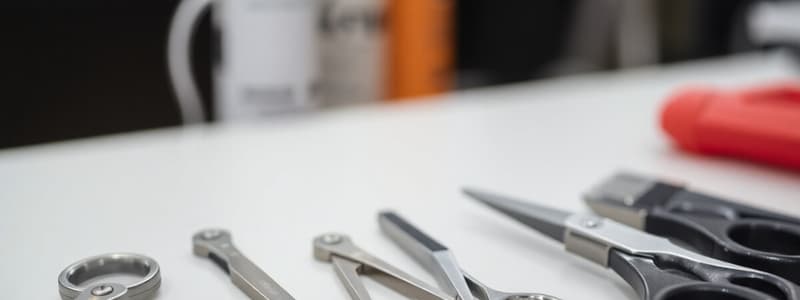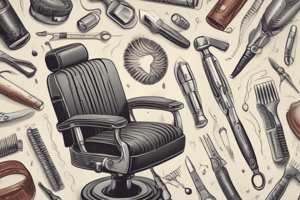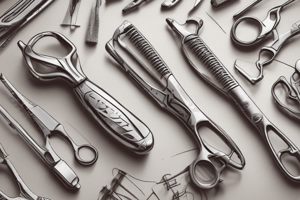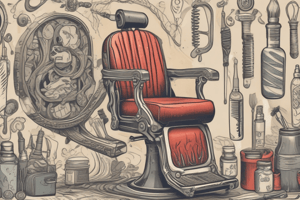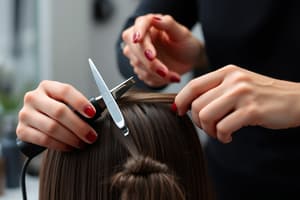Podcast
Questions and Answers
What is the primary purpose of thinning and blending shears in barbering?
What is the primary purpose of thinning and blending shears in barbering?
- To remove bulk and add texture (correct)
- To create sharp angles in a haircut
- To create a blunt cut
- To trim the ends of hair evenly
Which type of comb is typically utilized for haircutting?
Which type of comb is typically utilized for haircutting?
- Paddle comb
- Rattail comb
- Wide-tooth comb
- Taper comb (correct)
When measuring the lengths of haircutting shears, which sizes are most commonly used?
When measuring the lengths of haircutting shears, which sizes are most commonly used?
- 7 inches and 8 inches
- 4 inches and 6 inches
- 3 inches and 9 inches
- 5.5 inches and 6.5 inches (correct)
What is the main function of a strop in straight razor techniques?
What is the main function of a strop in straight razor techniques?
Which type of clipper motor is best suited for heavy-duty cutting tasks?
Which type of clipper motor is best suited for heavy-duty cutting tasks?
Flashcards are hidden until you start studying
Study Notes
Hair Cutting Tools
- Principal Barbering Tools: Shears, clippers, combs, razors, neck brushes, and styling aids.
- Combs: Taper combs, wide-tooth combs, and fine-tooth combs.
- Taper Combs: Effective for tapering, blending, and guiding hair.
- Shears: Two blades, a pivot, a screw, and finger rests.
- German & French Shears: German shears are generally heavier and more durable, while French shears are lighter and have a smoother feel.
- Shear Lengths: Measured in inches, most commonly used sizes are 5.5 inches to 6 inches for haircutting.
- Hollow-ground Blades: Found on professional haircutting shears, creating a smooth cutting edge.
- Thinning & Blending Shears: Thinning shears remove bulk, blending shears soften and blend hair.
- Clipper Motors: Magnetic, rotary, and pivot motors are the three main types.
- Adjustable-Blade Electric Clipper: Visible parts include the lever for adjusting the cutting length, the blade, and a feed adjustment dial.
- Closest Cut: Zero size (#0) blade gives the closest cut.
- Outliner Blade: Should never be set flush to avoid damaging the client's skin.
Straight Razor Techniques
- Straight Razors: Conventional and double-edged razors.
- Parts of a Straight Razor: The blade, the shank, the tang, the heel, and the point.
- Honing: Used to sharpen the razor.
- Hone Types: Leather, Arkansas, and India.
- Hone Positions and Strokes: First Position: Hone in a circular motion for the first 10-15 strokes. Second Position: Using a long, smooth stroke, hone down the length of the blade for the next 15-25 strokes.
- Stropping: Used to align and polish the blade.
- Best Strop: A horsehide strop is best for stropping a conventional straight razor.
- Strop Strokes: First Stroke: In an upward motion, from heel to point. Second Stroke: Reverse the stroke from point to heel.
Client Care and Other Tools
- Hair Removal Methods: Neck brush, neck duster, and vacuum cleaner.
- Thermal: Refers to heat or temperature.
- Galvanic Machine: Creates direct current to produce chemical changes in the skin.
- High-Frequency Services: Scalp treatments and skin rejuvenation.
- Comedone Extractor: Used to remove blackheads and pimples.
Studying That Suits You
Use AI to generate personalized quizzes and flashcards to suit your learning preferences.
